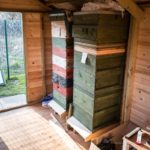Ribes sanguineum
It’s often said that the flowering of the flowering currant (Ribes sanguineum) is a good indicator of when to conduct the first hive inspection of the year. The BBKA Guide to Beekeeping and the excellent Get Started in Beekeeping by Adrian and Clare Waring (I consider the latter is one of the very best books for beginners) both contain this information. Of course, the advice is qualified by saying it should be a ‘shirtsleeve’ sort of day. I’ve even posted on this before, together with an image of the plant in full flower taken on the 11th of April in the Midlands. Today, more than a fortnight earlier than that photo was taken, I walked past a long row of them in full flower in St. Andrews.
Perhaps there are different strains of the flower as it still feels far too early to inspect colonies. The month has been consistently cool, with temperatures rarely into double figures, even in sheltered locations. Most colonies are starting to get busy, taking pollen in during the warmest couple of hours of the day. However, inspection of the bottom boards shows relatively little brood is being reared yet, with the characteristic darker nibbled wax cappings from only 2-3 frames at best. So … despite the indications of the flowering currant, I’d usually prefer to leave them in peace until they’ve built up a bit more.
Nevertheless, it was a gorgeous day and the bees were flying strongly when I checked on them at the bee shed. It was just over 10°C outside in the sun, but a balmy 19°C inside the shed. I fired up the smoker, popped on a jacket and had a brief look through one of the colonies. Ample stores, ample space and – most encouragingly – about 5 good frames of brood with the queen calmly sauntering about looking to fill in the gaps around the edges of the frame I found her on. Lovely. I switched a couple of frames of partially used stores to the outside, swapping them for drawn comb, so the colony could expand into the space, and quickly tidied up and closed the colony. I was finished in less than 5 minutes.
While the smoker cooled down the few bees that had escaped made their way out through the windows, the colony settled quickly and I re-stacked some piles of spare equipment for the season ahead. It’ll still be a week or three before I open up other colonies, particularly those ‘outside’, but it’s good to be beekeeping again.


Join the discussion ...